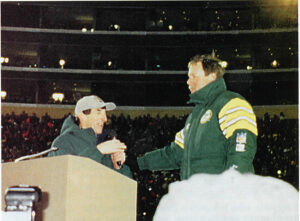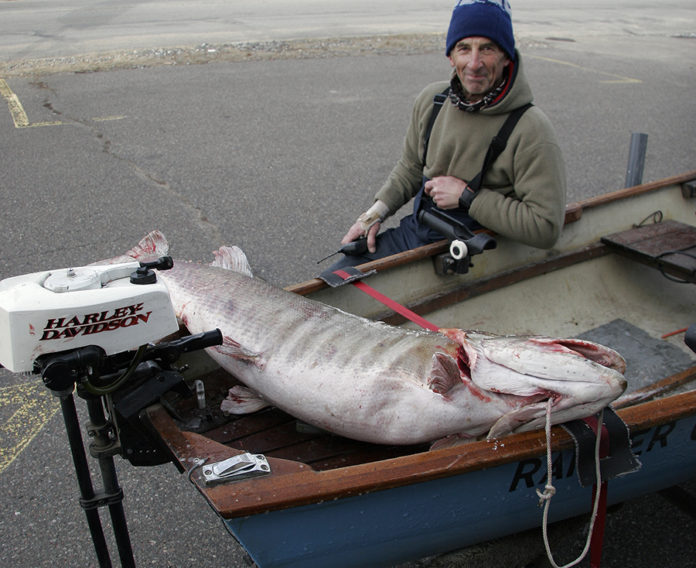The musky fishing world is mourning the death of noted angler Tom Gelb, who died at his home Christmas morning after a brief illness.
Gelb, 85, was one of Musky Hunter magazine’s original field editors and wrote dozens of articles for the magazine. “Tom was so popular with our readers that comments about him would often appear on correspondence they sent in,” recalls Musky Hunter Managing Editor Steve Heiting. “One reader survey came back to us with the words ‘Gelb is God!’ written on it.”
On November 30, 2006, the final day of Wisconsin’s musky season, Gelb caught the largest musky of his life, a 53-inch, 51-pound 2-ounce fish, while row trolling. The fish was the largest known musky caught in the state that year. He followed it up in 2007 with another fish nearly as big, a 52 3/4-inch, 48-pounder.
In 2012, Gelb wrote the book Musky Strategy, which is considered one of the most detailed musky books ever published.
Musky fishing legend Joe Bucher’s friendship with Gelb goes back around 40 years. Clyde Bailey, then-owner of Wildcat Lodge, paired the two up when Bucher was guiding in the Boulder Junction, Wisconsin, area.
“It all started with one fishing trip,” Bucher said. “Tom couldn’t believe the guides would quit at 4 or 4:30 so their customers could be back to the resorts for dinner. Tom wanted to fish dawn-to-dusk, and wanted somebody who would really pound the water. Clyde said there’s one guy, and that was me. Tom and I hooked up and we clicked. Pretty soon I started engaging Tom in all the things I did, making lures and everything else.”
Bucher saw something in Gelb he didn’t see in other fishermen. “Being a mechanical engineer, he would think things through at a different level … he had a scientific way of breaking things down. He was very skilled. He really didn’t have an achilles heal at fishing and was just a good musky angler in all phases,” Bucher said. “He was an outstanding Great Lakes troller, so when he started row trolling for muskies it was an easy transition. He was very meticulous, even to the way he sharpened hooks. People who think I have sharp hooks haven’t seen a Tom Gelb-sharpened hook.”
Bucher and Gelb were the first to use moon phases to predict the best musky fishing times, a practice now followed by almost all top anglers. “I started to figure out that I was catching big muskies around the moon, and I tipped Tom off to it,” Bucher said. “He being Mr. Engineer and Mr. Scientist, looked at it the Gelb way. Once he got onto it, he looked at moon overhead and underfoot, as well as moonrise and moonset. He built his own charts and followed them to a T, and he was very successful with it.”
Gelb’s engineering skills benefited Bucher’s tackle company, and he assisted in the development of such iconic lures as the DepthRaider, ShallowRaider and TopRaider, and their various sizes and versions. “I was the innovation guy and Tom was the let’s-get-this-done-into-a-written-down-measurable-position-so-we-can-present-this-to-somebody-so-it-can-be-produced guy,” Bucher said.
When Bucher helped launch Musky Hunter magazine, he wanted Gelb involved right away. “I wanted to get all the accomplished anglers in North America who loved muskies writing for the magazine to have a good exchange of ideas,” Bucher explained. “I wanted everybody else to know what kind of an angler Tom was, and he turned out to be a very unique product and personality for the magazine.”
Musky Hunter TV host Jim Saric, who published Musky Hunter magazine from 1998 to 2018, called Gelb a legend. “Tom was known for analyzing and dissecting many aspects of the sport. He pioneered the impacts of moonrise/set on muskies, how suspended muskies relate to the thermocline, as well as some cold water figure-8 techniques,” Saric said. “All of this is now common knowledge to today’s musky angler, which is testament to Tom’s impact to the sport. He will be missed.”
Heiting, who edited and designed Gelb’s Musky Strategy, called him “the most interesting man” he has ever met, and had a humorous story about the day Gelb caught his 51-pound musky.
“Well into his 70s, Tom liked to trap beavers for something to do in winter,” Heiting recalled. “He caught his largest beavers during prime moon phases, just like muskies. One day Tom called to say he would be at the Musky Hunter office shortly with a 60-pounder, hoping I would think he had a 60-pound musky. He showed up with a 60-pound beaver, which was a huge animal.
“On the morning he caught his 51-pound musky, I got a call at the office from an excited Tom Gelb who shouted in my ear ‘I got a 50-pounder! Get your camera!’
“I replied, ‘What? A beaver?’
“‘I’m not joking!’ Gelb shot back. ‘I got a 50-pound musky and you need to get your camera and meet me at Eagle Sports Center!’ and he hung up,” Heiting laughed.
“When I arrived at Eagle Sports, I found a giant musky hanging from the scale outside and Tom Gelb with a smile of accomplishment on his face. It was a day I’ll never forget,” Heiting concluded.
Gelb started fishing seriously in 1949 when he was “adopted” by one of his grade school teachers, Joe Cannon, and caught his first musky in Vilas County on opening weekend in 1952. He became addicted to the sport and spent his summers guiding in northern Wisconsin during the summer from 1954-1956.
Gelb primarily fished for muskies in northern Wisconsin but made trips to Lake of the Woods two or three times each season. He eventually focused on row trolling in northern Wisconsin as he believed that was how he would catch the region’s largest muskies. Gelb’s blue Kuehl row troller became a fixture on a number of waters in the Vilas and Oneida County region.
Gelb gave numerous presentations at musky shows and clubs, and tallied well over 1,000 muskies caught and released over the years. He fished all over the world, including fly fishing trips to Russia and Argentina.

But Gelb was more than a fisherman. During the 1960s, he raced motorcars and at one time held lap records on four Midwest racetracks, including Road America. Late in his racing career, he flipped his orange No. 66 Formula B car and spun down the track on his roll bar and helmet, leaving circular skid marks on the helmet.
Gelb worked at Harley-Davidson most of his adult life, and served in vice president positions in engineering, manufacturing, continuous improvement, and finally senior vice president of operations, before retiring in 1997. He played an integral role in the legendary turnaround at Harley in the 1980s. In 1997, he presented Green Bay Packers Coach Mike Holmgren with a Harley during the Return to Titletown celebration at Lambeau Field following the Packers’ victory in Super Bowl XXXI.
Thomas Alfred Gelb was born May 24, 1935, to Charles E. Gelb and Florence Decker Gelb, in the Chicago area.
He is survived by his wife, Toni; son Matthew (Katie) Gelb of Green Bay, Wisconsin; daughter Amy Gelb (David Geoffroy) of Encinitas, California; Toni’s children Cindy (Tony) Romandine of De Pere, Wisconsin, Sarah (Scott) Mooney of the Town of Dane, Wisconsin, and Jennifer (Michael) Clemens of Mequon, Wisconsin; and many grandchildren, nieces and nephews.
Visitation will be at St. Peter the Fisherman Catholic Church in Eagle River, Wisconsin, on Wednesday, December 30, from 12 pm to 1 pm. A Funeral Mass will be celebrated at 1 pm.
Did you like this? Share it:
Credit: Source link






























